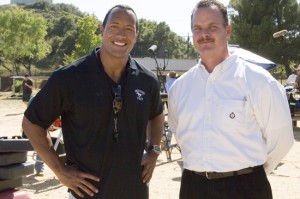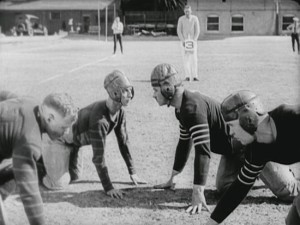Super Bowl Guide to Football Films
The sport was fodder for slapstick comedy, but as the technology evolved, so did the way in which filmmakers portrayed the gridiron on the big screen
/https://tf-cmsv2-smithsonianmag-media.s3.amazonaws.com/filer/20120201110126Horsefeathers_thumb.jpg)
Sunday’s Super Bowl XLVI, pitting the New York Giants against the New England Patriots, will be one of the highest-rated shows on television this year. (Last year’s game was the most watched show in television history; it was also the fourth consecutive Super Bowl to set viewership records.) Advertising revenue for the broadcast will top well over a half-billion dollars. The game and its surrounding pageantry are so significant that some churches have closed rather than compete, while a counter-programming industry has sprung up to capitalize on disaffected consumers.
Football hasn’t always been so dominant in American culture. In fact, for years the sport barely registered outside of college alumni fans. Baseball was considered the “national pastime,” and as such was frequently a setting in film. Prizefights, on the other hand, played a major role in legitimizing the entire medium, as Dan Streible points out in Fight Pictures: A History of Boxing and Early Cinema. (Interestingly, boxing had a similar function with television.)
Apart from newsreels and actualities (like this 1903 Edison film of a game between the University of Chicago and the University of Michigan), Hollywood took a bemused attitude towards football, using it largely as a setting for collegiate humor. In 1925, Harold Lloyd’s The Freshman and MGM’s Brown of Harvard, starring William Haines and Jack Pickford, covered similar territory: plucky collegians, gorgeous co-eds, proms, cheers, betrayals and the Big Game. The Marx Brothers took a blowtorch to the genre in Horsefeathers, but cartoons like Freddy the Freshman also mocked the raccoon coats, Model Ts, and convoluted offenses that were how most viewers perceived college football.
These films inadvertently pointed out a problem with portraying the sport on screen. When newsreel companies like Fox Movietone and Pathé covered big games, their cameras were almost always situated high in the stands, at the equivalent of the 50-yard line—the best position for cinematographers to cover a play that could extend to either end zone. In Horsefeathers or Buster Keaton’s The Three Ages (1923), on the other hand, filmmakers could break plays into individual components, concentrating on one or more players, cutting from a quarterback to a receiver, switching from sideline to end zone, even tracking along with runners as the play and story demanded.
Football became increasingly more popular in the 1950s and 1960s, in part because of how it was broadcast on television. Just like they did with baseball, sports directors learned to turn football games into narratives. As CBS director Sandy Grossman put it, “The reason is easier to cover is because every play is a separate story. There’s a beginning, a middle, and an end, and then there’s 20 or 30 seconds to retell it or react to it.”
Now just about every player on the field can be isolated during a play, allowing the director to build a story line from different takes. Slow motion enables viewers to see precisely where a play succeeds or fails. Off-field graphics and interviews inserted into the game build personalities for the players, who otherwise might appear anonymous.
Contrast a football game with hockey or soccer, where play is essentially nonstop, forcing cameramen to revert to a high-shot from the middle of the rink or field. Or with basketball, where games are usually decided only in the final minutes. (Baseball, with its many points of stasis, trumps even football in terms of how successfully it can be televised. Because players are more or less stationary for most of the game, directors can hone in on them in close-ups so tight even Sergio Leone would have been impressed.)
As the means for depicting football evolved, both on television and in movies, so did the way the game was treated. From comedies that emphasized the frivolity of the sport, Hollywood moved to biopics like Knute Rockne All American (1940). Here football served as an all-purpose metaphor: for our struggle with adversity, as an affirmation of the American way of life, as an example of how we will defeat our enemies. Knute Rockne grew out of the Warner Bros. version of history, in which figures like Louis Pasteur and Emile Zola received reverential treatment in biopics, and was constructed as a morale-builder as the country faced the onset of World War II. It’s known today mostly for Ronald Reagan’s performance as George Gipp. (One football film that’s often overlooked is the engaging Easy Living, starring Victor Mature and Lucille Ball, which took a relatively hard view of the sport’s injuries and their consequences.)

Dwayne "The Rock" Johnson (left) with Sean Porter, the coach he portrayed in Columbia Pictures' Gridiron Gang.
Like movies in general, sports films became more psychologically complex in the 1950s and beyond. Titles like Paper Lion, Brian’s Song, and North Dallas Forty presented a more realistic view of the game and its players, albeit while romanticizing football overall. But filmmakers still tended to treat the sport as a metaphor: disapproving in Everybody’s All-American, uplifting in Rudy.
Rudy marked another recent shift to true-life stories centered around football. Friday Night Lights, Remember the Titans, Invincible, Gridiron Gang, The Express and Radio are a few examples of films based on true stories. 2009′s The Blind Side, based loosely on a book by Michael Lewis, hit the jackpot, winning Sandra Bullock a Best Actress Oscar.
While The Blind Side was being filmed, Dan Lindsay and T.J. Martin were shooting a documentary on the Manassas High School Tigers. The finished film, Undefeated, received an Oscar nomination for Documentary Feature. Again, the filmmakers insist that Undefeated isn’t a “football” movie.
“One of the biggest challenges is telling people what Undefeated is about,” Martin told me in a phone conversation. “If you say, ‘It’s a high school football team…’ they answer, ‘Oh, like Friday Night Lights.’ But it’s not, Undefeated is about something different than football.”
And in fact Undefeated paints a touching and at times troubling portrait of North Memphis youths struggling to find their way in the world. As coach Bill Courtney says at one point, “You think football builds character. It does not. Football reveals character.”
Which gets me through this posting without having to deal with Black Sunday, in which a suicidal lunatic played by Bruce Dern tries to blow up the Goodyear Blimp at Super Bowl X.
/https://tf-cmsv2-smithsonianmag-media.s3.amazonaws.com/accounts/headshot/daniel-eagan-240.jpg)

/https://tf-cmsv2-smithsonianmag-media.s3.amazonaws.com/accounts/headshot/daniel-eagan-240.jpg)